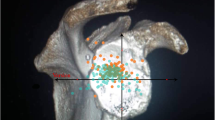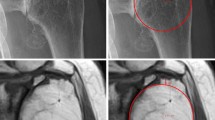Abstract
Purpose
Computed tomography osteoabsorptiometry (CTO) is a method to analyze the stress distribution in joints by measuring the subchondral bone density. The purpose of this study was to evaluate the bone mineralization changes of the glenoid in shoulders with rotator cuff tears by CTO and to evaluate whether rotator cuff tears are associated with stress changes in the glenoid.
Methods
In total, 32 patients, who were diagnosed with unilateral rotator cuff tears and underwent arthroscopic rotator cuff repair, were enrolled in this study. They underwent CT scanning of both shoulders pre-operatively and the glenoid was evaluated using CTO. Hounsfield units (HU) in seven areas of the glenoid were compared between the affected and unaffected sides.
Results
The central area of the glenoid on the affected side had significantly lower HU than on the unaffected side among all patients. Focusing on the rotator cuff tear size and the subscapularis tendon, only patients with larger cuff tears or with subscapularis tendon tears showed significantly lower HU in the central area of the affected side.
Conclusions
This study showed a decrease in bone mineralization density in the central glenoid in shoulders with rotator cuff tear. This change was observed in the case of larger cuff tears and subscapularis tendon tears. Our results help clarify the changes in stress distribution in the shoulder joint caused by symptomatic rotator cuff tears.


Similar content being viewed by others
References
Thompson WO, Debski RE, Boardman ND 3rd, Taskiran E, Warner JJ, Fu FH, Woo SL (1996) A biomechanical analysis of rotator cuff deficiency in a cadaveric model. Am J Sports Med 24:286–292. https://doi.org/10.1177/036354659602400307
Reuther KE, Thomas SJ, Tucker JJ et al (2014) Disruption of the anterior-posterior rotator cuff force balance alters joint function and leads to joint damage in a rat model. J Orthop Res 32:638–644. https://doi.org/10.1002/jor.22586
Burkhart SS (1991) Arthroscopic treatment of massive rotator cuff tears. Clinical results and biomechanical rationale. Clin Orthop Relat Res 267:45–56
Parsons IM, Apreleva M, Fu FH, Woo SL (2002) The effect of rotator cuff tears on reaction forces at the glenohumeral joint. J Orthop Res 20:439–446. https://doi.org/10.1016/S0736-0266(01)00137-1
Steenbrink F, de Groot JH, Veeger HE, van der Helm FC, Rozing PM (2009) Glenohumeral stability in simulated rotator cuff tears. J Biomech 42:1740–1745. https://doi.org/10.1016/j.jbiomech.2009.04.011
Dunn WR, Kuhn JE, Sanders R et al (2014) Symptoms of pain do not correlate with rotator cuff tear severity: a cross-sectional study of 393 patients with a symptomatic atraumatic full-thickness rotator cuff tear. J Bone Joint Surg Am 96:793–800. https://doi.org/10.2106/JBJS.L.01304
Carter DR, Fyhrie DP, Whalen RT (1987) Trabecular bone density and loading history: regulation of connective tissue biology by mechanical energy. J Biomech 20:785–794
Müller-Gerbl M, Putz R, Hodapp N, Schulte E, Wimmer B (1989) Computed tomography-osteoabsorptiometry for assessing the density distribution of subchondral bone as a measure of long-term mechanical adaptation in individual joints. Skelet Radiol 18:507–512
Egloff C, Paul J, Pagenstert G, Vavken P, Hintermann B, Valderrabano V, Müller-Gerbl M (2014) Changes of density distribution of the subchondral bone plate after supramalleolar osteotomy for valgus ankle osteoarthritis. J Orthop Res 32:1356–1361. https://doi.org/10.1002/jor.22683
Müller-Gerbl M, Putz R, Hodapp NH, Schulta E, Wimmer B (1990) Computed tomography-osteoaboorptiometry: a method of assessing the mechanical condition of the major joints in a living subject. Clin Biomech (Bristol, Avon) 5:193–198. https://doi.org/10.1016/0268-0033(90)90002-N
Nishida K, Iwasaki N, Fujisaki K et al (2012) Distribution of bone mineral density at osteochondral donor sites in the patellofemoral joint among baseball players and controls. Am J Sports Med 40:909–914. https://doi.org/10.1177/0363546511435085
Anetzberger H, Schulz C, Pfahler M, Refior HJ, Müller-Gerbl M (2002) Subchondral mineralization patterns of the glenoid after tear of the supraspinatus. Clin Orthop Relat Res 404:263–268
Yokoya S, Mochizuki Y, Omae H et al (2006) Analysis of stress distribution of glenoid with DMSB (distribution of mineralization of subchondral bone plate) by CT osteoabsorptiometry [in Japanese]. Katakansetsu 30:375–378. https://doi.org/10.11296/katakansetsu1977.30.3_375
Cofield RH (1981) Tears of rotator cuff. Instr Course Lect 30:258–273
Mochizuki Y, Natsu K, Kashiwagi K, Yasunaga Y, Ochi M (2005) Changes of the mineralization pattern in the subchondral bone plate of the glenoid cavity in the shoulder joints of the throwing athletes. J Shoulder Elb Surg 14:616–619
Fleiss JL (1981) Statistical methods for rates and proportions. John Wiley & Sons, New York
Schulz CU, Pfahler M, Anetzberger HM et al (2002) The mineralization patterns at the subchondral bone plate of the glenoid cavity in healthy shoulders. J Shoulder Elb Surg 11:174–181
Müller-Gerbl M, Putz R, Kenn R (1993) Distribution pattern of subchondral mineralization in the glenoid cavity in normal subjects, athletes and patients. Z Orthop Ihre Grenzgeb 131:10–13
Shimizu T, Iwasaki N, Nishida K, Minami A, Funakoshi T (2012) Glenoid stress distribution in baseball players using computed tomography osteoabsorptiometry: a pilot study. Clin Orthop Relat Res 470:1534–1539. https://doi.org/10.1007/s11999-012-2256-0
Kawasaki T, Sashi R, Moriya S et al (2013) Computed tomography osteoabsorptiometry for assessing the density distribution of subchondral bone as a measure of long-term mechanical stress in the “rugby shoulder”. J Shoulder Elb Surg 22:800–806. https://doi.org/10.1016/j.jse.2012.07.015
Nagai M, Suenaga N, Oizumi N, Kato H, Yamane S, Minami A (2002) The stress distribution of the glenoid using by CT osteoabsoptiometry [in Japanese]. Katakansetsu 26:541–544. https://doi.org/10.11296/katakansetsu.26.541
Lugo R, Kung P, Ma CB (2008) Shoulder biomechanics. Eur J Radiol 68:16–24. https://doi.org/10.1016/j.ejrad.2008.02.051
Hirata Y, Inaba Y, Kobayashi N et al (2013) Comparison of mechanical stress and change in bone mineral density between two types of femoral implant using finite element analysis. J Arthroplast 28:1731–1735. https://doi.org/10.1016/j.arth.2013.04.034
Kim KK, Won YY, Heo YM et al (2014) Changes in bone mineral density of both proximal femurs after total knee arthroplasty. Clin Orthop Surg 6:43–48. https://doi.org/10.4055/cios.2014.6.1.43
Author information
Authors and Affiliations
Corresponding author
Ethics declarations
Conflict of interest
The authors declare that they have no conflict of interest.
Ethical approval
The institutional review board approved this study.
This article was approved by our Ethical Committee of Research.
Informed consent
Informed consent was obtained from all individual participants included in the study.
Rights and permissions
About this article
Cite this article
Harada, Y., Yokoya, S., Akiyama, Y. et al. Bone mineralization changes of the glenoid in shoulders with symptomatic rotator cuff tear. International Orthopaedics (SICOT) 42, 2639–2644 (2018). https://doi.org/10.1007/s00264-018-4004-x
Received:
Accepted:
Published:
Issue Date:
DOI: https://doi.org/10.1007/s00264-018-4004-x




